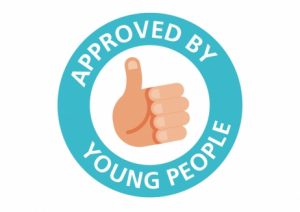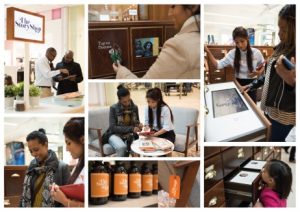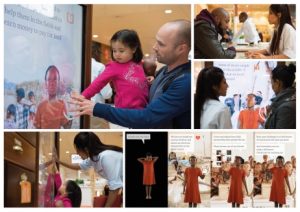Main Content

Digging deep: understanding the end-user to deliver design driven results
Mental health in young people is a soaring issue, from anxiety brought about by the pressure of school and social media, to complex feelings about food, self-harm and self-worth. Yet mental health services are still shockingly under-resourced.
One NHS Clinical Commissioning Group (CCG) is leading the field in transforming support for young people via a mental health services hub; an online platform that is much more than a website. MindMate has quickly become the ‘trusted friend’ that young people turn to and since its launch has helped thousands of young people with real problems, who might not have found help otherwise.
The crux of MindMate’s success: the level of user involvement applied from the very outset of the project, the integration of users into the entire process – even down to involving young people in the selection of the design agency.
 “Everyone knows designing a website around its users is essential,” but says chosen agency, Thompson Brand Partner’s Rachel Cook, “I’ve not seen anything like this early, entirely integrated user involvement in other client projects. Young people truly affected everything, from choosing their agency, leading and approving content, feeding into wireframes, voting on naming and terminology use, selecting the direction of the illustration style. It’s incredibly comprehensive.”
“Everyone knows designing a website around its users is essential,” but says chosen agency, Thompson Brand Partner’s Rachel Cook, “I’ve not seen anything like this early, entirely integrated user involvement in other client projects. Young people truly affected everything, from choosing their agency, leading and approving content, feeding into wireframes, voting on naming and terminology use, selecting the direction of the illustration style. It’s incredibly comprehensive.”
NHS Leeds South & East CCG and Thompson are to be applauded for their agile, user-centric approach and solution: MindMate’s design, content and language were shaped by young people all the way through, ensuring it deals with the most extreme sensitivities in a way that relates rather than patronises, makes sense of the help and support available, and critically engages its audience.
It’s a stunningly effective design: since launch, MindMate has smashed targets, inspired the sector, created an ambassador programme and become a template for other CCGs.
Physically winning the MindMate project involved an initial chemistry meeting with the client and a young person; the shortlisted agencies then had to carry out three practical workshops with young people before Thompson was chosen.
“Whilst this user-centric process undoubtedly means that more time and money will need to be spent on user engagement, it pays dividends by helping you to make smart decisions, quickly, and therefore cost-effectively,” points out Cook. “No matter how in touch we think we are with our audience, you can’t ever really second guess your users. We never failed to be surprised about what they felt worked and what didn’t.”
The process, she adds, can also help the client “to reassure stakeholders that they’re taking every precaution in ensuring the success of the project.”
 This level of deep understanding of the customer is helping one charity innovate in the retail space, enabling it to grow at a tough time for the charity sector. As a result, World Vision UK is trailblazing the way non-profit organisations think about face-to-face fundraising.
This level of deep understanding of the customer is helping one charity innovate in the retail space, enabling it to grow at a tough time for the charity sector. As a result, World Vision UK is trailblazing the way non-profit organisations think about face-to-face fundraising.
With the help of retail design consultancy The Yard Creative (TYC), the international children’s charity repositioned sponsor acquisitions away from the mass market and focused on a specific post-demographic consumer with a proven high lifetime value – (defined in summary as) affluent women aged 40-60.
“By putting the donor at the heart of the fundraising activity you begin to understand more than just the demographics,” says Steve James-Royle, co-founder of TYC, whose ‘Story Shop’ concept for the charity has helped deliver child sponsorship acquisitions 65% above target for the charity through its unique and rich customer experience.
Research had revealed the potential synergy between premium shopping centres and the desired target market, but high-end mega malls were refusing entry to World Vision due to the negative perception of charities’ traditional face-to-face fundraising.
 The insights TYC gained from the customer research identified the need for emotion in retail. “The target audience can see through the average marketing spin of everyday,” James-Royle says, “What they want is meaningful connections.”
The insights TYC gained from the customer research identified the need for emotion in retail. “The target audience can see through the average marketing spin of everyday,” James-Royle says, “What they want is meaningful connections.”
This focused TYC on the emotional connection needed to convert potential sponsors. They adopted a creative, retail minded approach, moving away from an intrusive fundraising experience that repels, to an enjoyable, immersive, technology driven, retail led experience that potential sponsors openly choose to engage with and TYC engaged the target audience throughout to understand how they would react to the design.
The Story Shop was born: designed as a mid-mall retail kiosk with the look of a specialist vintage store – customers can explore the interactive drawers at their own leisure to read the story of World Vision. The experience not only resonated deeply with the identified customer, but also gained the trust of wary landlords. “We involved them throughout the whole concept design process and enabled them to input,” says James-Royle, “They then did their bit to ensure World Vision was seen as a ‘retailer’ and that it would be good for their business.”
But there’s no resting on their laurels for either of these initiatives – both agencies are now involved in the next generations of the projects. “It’s vital that MindMate stays up to date, both as services and advice changes,” but also says Cook, “to keep talking to our users so we know what they need.”
No matter how much you think you know about your audience, it’s always worth digging deeper.
MindMate and The Story Shop are both winners in the 2017 DBA Design Effectiveness Awards.
Image credits: © Convisum | Dreamstime.com